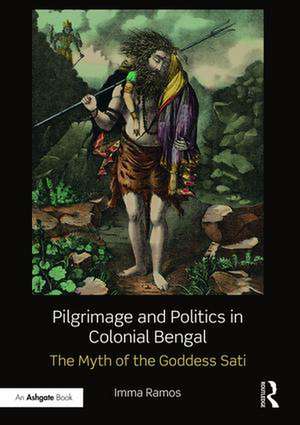Pilgrimage and Politics in Colonial Bengal: The Myth of the Goddess Sati
Autor Imma Ramosen Limba Engleză Hardback – 3 mar 2017
| Toate formatele și edițiile | Preț | Express |
|---|---|---|
| Paperback (1) | 243.44 lei 6-8 săpt. | |
| Taylor & Francis – 21 ian 2023 | 243.44 lei 6-8 săpt. | |
| Hardback (1) | 847.31 lei 6-8 săpt. | |
| Taylor & Francis – 3 mar 2017 | 847.31 lei 6-8 săpt. |
Preț: 847.31 lei
Preț vechi: 1140.21 lei
-26% Nou
Puncte Express: 1271
Preț estimativ în valută:
162.14€ • 167.52$ • 134.88£
162.14€ • 167.52$ • 134.88£
Carte tipărită la comandă
Livrare economică 19 martie-02 aprilie
Preluare comenzi: 021 569.72.76
Specificații
ISBN-13: 9781472489449
ISBN-10: 1472489446
Pagini: 138
Ilustrații: 76
Dimensiuni: 174 x 246 mm
Greutate: 0.43 kg
Ediția:1
Editura: Taylor & Francis
Colecția Routledge
Locul publicării:Oxford, United Kingdom
ISBN-10: 1472489446
Pagini: 138
Ilustrații: 76
Dimensiuni: 174 x 246 mm
Greutate: 0.43 kg
Ediția:1
Editura: Taylor & Francis
Colecția Routledge
Locul publicării:Oxford, United Kingdom
Cuprins
Contents
Introduction
A myth of dismemberment
Sati and her rise as a patriotic icon
The formation of Hindu identity: From cultural to revolutionary nationalism
Layout of the book
Chapter One
Kalighat souvenirs and the creation of Sati’s iconography
Sati’s place in the visual rhetoric of motherland
Sati’s portrayal in Kalighat pilgrimage souvenirs
The invocation and reinvention of Sati
The romanticisation of martyrdom
Subverting Christian iconography
Shiva, asceticism and Bengali masculinity
Sati, suttee and the story of Padmini
The enduring power of Sati
Chapter Two
Kamakhya’s erotic-apotropaic potency and the forging of sacred geography
Martial and maternal: Kamakhya’s sculptures
The promotion of fertility and protection: Kamakhya’s female archers
Subversive sexuality: The reception of Kamakhya during the colonial period
Colonial mapping versus sacred geography
Bengal’s love affair with Kamakhya: Pilgrimage as a nationalist device
Chapter Three
Tantra’s revolutionary potential: Tarapith and Bamakhepa’s visualisation of Tara
Understanding Tara
Understanding Tantric ritual through Tara
Bamakhepa, Tantra and revolutionary potential
Terrifying and benevolent: Visions of Tara
The sweetening of death
Chapter Four
Contesting the colonial gaze: Image worship debates in nineteenth-century Bengal
Murtipuja, darshan and rituals of consecration
Ram Mohan Roy and the Brahmo Samaj movement
‘Inconsistent with the moral order of the universe’: The Reverend Hastie’s views on murtipuja
The backlash: Bengali responses to Hastie
The Saligram idol case: Murti and artefact
The Attahas and Khirogram Pithas: The charisma of antique murtis
Conclusion
Epilogue
Reviving Sati’s corpse: Mother India tours and Hindutva in the twenty-first century
Bibliography
Introduction
A myth of dismemberment
Sati and her rise as a patriotic icon
The formation of Hindu identity: From cultural to revolutionary nationalism
Layout of the book
Chapter One
Kalighat souvenirs and the creation of Sati’s iconography
Sati’s place in the visual rhetoric of motherland
Sati’s portrayal in Kalighat pilgrimage souvenirs
The invocation and reinvention of Sati
The romanticisation of martyrdom
Subverting Christian iconography
Shiva, asceticism and Bengali masculinity
Sati, suttee and the story of Padmini
The enduring power of Sati
Chapter Two
Kamakhya’s erotic-apotropaic potency and the forging of sacred geography
Martial and maternal: Kamakhya’s sculptures
The promotion of fertility and protection: Kamakhya’s female archers
Subversive sexuality: The reception of Kamakhya during the colonial period
Colonial mapping versus sacred geography
Bengal’s love affair with Kamakhya: Pilgrimage as a nationalist device
Chapter Three
Tantra’s revolutionary potential: Tarapith and Bamakhepa’s visualisation of Tara
Understanding Tara
Understanding Tantric ritual through Tara
Bamakhepa, Tantra and revolutionary potential
Terrifying and benevolent: Visions of Tara
The sweetening of death
Chapter Four
Contesting the colonial gaze: Image worship debates in nineteenth-century Bengal
Murtipuja, darshan and rituals of consecration
Ram Mohan Roy and the Brahmo Samaj movement
‘Inconsistent with the moral order of the universe’: The Reverend Hastie’s views on murtipuja
The backlash: Bengali responses to Hastie
The Saligram idol case: Murti and artefact
The Attahas and Khirogram Pithas: The charisma of antique murtis
Conclusion
Epilogue
Reviving Sati’s corpse: Mother India tours and Hindutva in the twenty-first century
Bibliography
Notă biografică
Imma Ramos is Curator of the South Asia Collections at the British Museum, UK.
Recenzii
“Ramos’ book is a compelling read and an important contribution to our larger understanding of the complex intersections between religion, politics, sacred space, pilgrimage, and national identity. … [This] is an important book that should be of genuine interest to anyone interested in the study of pilgrimage, sacred space, religious nationalism, and modern Indian history.”
--Journal of South Asian Studies
“Ramos weaves a narrative from the threads of traditional religious practices, shrines, visual culture, and politics into a whole cloth that gives us a better sense of the Bengali imagination undergoing its transformations of modernity in its distinctive way. Highly recommended.”
--Bulletin of the School of Oriental and African Studies
“This is a fascinating and well-crafted study that dwells substantially in the concrete rather than in the theoretical or the historiographical. … Historians of Indian nationalism, art historians, and scholars of South Asian religion will all learn much from this valuable work.”
--International Journal of Hindu Studies
--Journal of South Asian Studies
“Ramos weaves a narrative from the threads of traditional religious practices, shrines, visual culture, and politics into a whole cloth that gives us a better sense of the Bengali imagination undergoing its transformations of modernity in its distinctive way. Highly recommended.”
--Bulletin of the School of Oriental and African Studies
“This is a fascinating and well-crafted study that dwells substantially in the concrete rather than in the theoretical or the historiographical. … Historians of Indian nationalism, art historians, and scholars of South Asian religion will all learn much from this valuable work.”
--International Journal of Hindu Studies
Descriere
This book represents the first attempt to study an ancient network of pilgrimage sites, known as Shakti Pithas, dedicated to the Hindu goddess Sati in an art historical and political context. During the nineteenth century these sites were re-imagined by Bengali writers and artists as the fragmented body of the motherland that could provide the basis for an emergent territorial consciousness.
